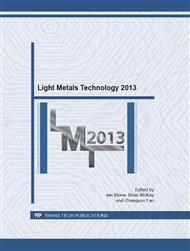p.241
p.245
p.250
p.255
p.260
p.266
p.271
p.276
p.281
A Study of the Behaviour of Double Oxide Films in Al Alloy Melts
Abstract:
The mechanical properties of Al castings are reduced by inclusions, particularly double oxide films, or bifilms, which are formed due to surface turbulence of the liquid metal during handling and/or pouring. These defects have been reported not only to decrease the tensile and fatigue properties of Al alloy castings, but also to increase their scatter. Recent research has suggested that the nature of oxide film defects may change with time, as the air inside the bifilm would react with the surrounding melt leading to its consumption, which may enhance the mechanical properties of Al alloy castings. In order to follow changes in the composition of the internal atmosphere of a double oxide film defect within an Al melt, a series of analogue experiments were carried out to determine the changes in gas composition of an air bubble trapped in a melt of commercial purity Al, subjected to stirring. The bubble contents were analysed using a mass spectrometer to determine their change in composition with time. Also, the solid species inside the bubbles solidified in the melt were analysed. The results suggested that first oxygen and then nitrogen inside the bubble were consumed, with consumption rates of 2.5x10-6 and 1.3x10-6 mol m-2s-1, respectively. Also, hydrogen diffused into the bubble from the melt at an average rate of 3.4x10-7 mol m-2s-1, although the rate of H diffusion increased significantly after the consumption of most of the oxygen inside the bubble. Based upon these reaction rates the time required for a typical alumina bifilm to lose all its oxygen and nitrogen was determined to be just under 10 minutes.
Info:
Periodical:
Pages:
260-265
Citation:
Online since:
July 2013
Keywords:
Price:
Сopyright:
© 2013 Trans Tech Publications Ltd. All Rights Reserved
Share:
Citation:


